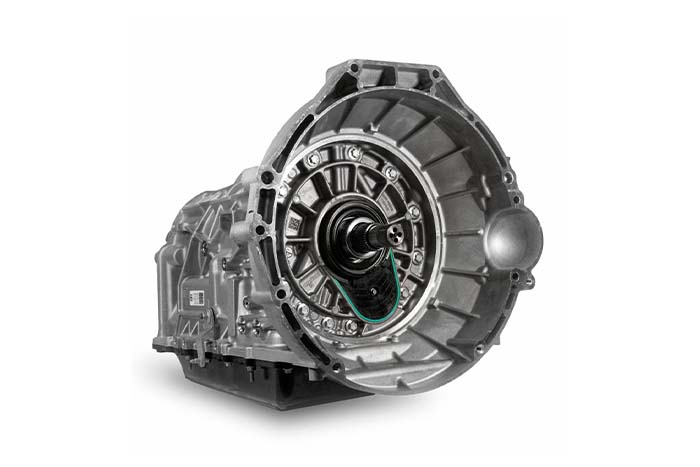The Ford 10R80 10-speed transmission has been installed in numerous Ford and Lincoln vehicles from 2017 and is still in use in 2023 models. The transmission is an electric model that provides ten forward gears and is intended to provide a silky smooth shift, but many owners have reported problems with the transmission. Ford has issued a voluntary recall on some models, while a class-action lawsuit seeks to hold Ford Motor Company responsible for several other significant issues.
Owners should be aware of some of the most common problems with the Ford 10-speed automatic transmission. Some of the most common issues can be fixed, but some problems may require a dealership service department. Knowing the problems with the 10R80 transmission can help owners avoid transmission issues. In this article, we will get in-depth with the Ford 10R80 transmission and explain what problems it has that owners need to know about.
Table of Contents
Overview Of The Ford 10-Speed Transmission

The Ford 10R80 automatic transmission was developed in collaboration with General Motors. Working together, the two companies produced a nine-speed transmission used in various transverse applications and the 10R80 10-speed transmission that Ford ultimately decided to use in Ford F-150 trucks and the Ford Mustang.
Ford says the 10R80 automatic transmission incorporates three overdrive gears that produce a unit with an extremely wide ratio range of 7.4:1. Narrow shift points between gears allow the engine to maintain rotating energy for smoother shifts and consistent acceleration. A turbine-style clutch with an integrated torque converter provides proper shifts, and an integrated front pump allows the transmission to take advantage of start/stop functionality for improved economy without hesitation on restart.
The electronically-controlled 10R80 transmission takes advantage of real-time algorithms that use more than a dozen input signals from the transmission controller and the driver to allow the transmission to be in the proper gear at any given time. The transmission controller will even provide RPM matching on coasting to allow seamless downshifts.
The transmission uses a shifting strategy Ford calls “single-step” and “double-step” shifting. Essentially, the transmission can make upshifts and downshifts from one gear to the next when the vehicle is being driven slowly or under a load or skip up two gears when accelerating quickly.
The 10R80 is a brand-new design that is not based on previous transmissions. It features a compact size that allows the transmission to fit in the same space as existing transmissions to save remanufacturing costs. Many of the Ford 10R80 transmissions perform flawlessly, but some suffer from reliability issues. Most of the common failures these transmissions suffer from are due to inferior quality parts used for cost-savings by Ford.
Common Ford 10-Speed Transmission Problems
Despite a design that should produce an exceptionally well-behaved transmission ideal for use in F-150 trucks and a variety of other light and medium-duty applications, the 10R80 10-speed transmission has proven to be somewhat problematic since it was introduced in 2017. Ford recalled about 47,000 light trucks due to an error that could allow the transmission to shift into neutral while driving. This potentially serious problem can result in a significant accident. In addition to the problem identified by Ford, owners have also reported a broad range of problems that cause various issues, from check engine lights and erratic shifting to total transmission failure.
— Rough Shifting
One of the most common issues that owners of Ford vehicles running the 10-speed transmission report are rough shifting. Sometimes, the shifts can be violent enough to cause neck and back issues, including whiplash. There are several reasons that these transmissions may exhibit rough shifting. The issue could result from worn or damaged components, sticking solenoid valves, or errors in the computer controller shift strategy algorithms that cause the transmission to shift at the wrong time or into the wrong gear.
Some owners reported rough shifting issues as soon as they purchased the vehicle, while other issues developed over time. Ford has issued a service bulletin directing repair techs to reprogram the powertrain controller. Ford notes that after the update, the transmission may upshift and downshift more firmly as the software “learns” a driver’s behavior.
— Gear Position Indicator Malfunction
The 10R80 can exhibit an issue whereby the gear position indicator light does not illuminate when the vehicle is in gear. While this is less of a safety issue than some of the problems with the transmission, the lack of an indicator light can present some problems, such as selecting the proper range when it is dark. This problem tends to be one of the more difficult to figure out a solution for since the wiring running to the illuminator is also used by other components.
Some owners successfully resolved the illuminator light issue by turning the lights off and back on. At least one owner resolved the issue by operating the power windows. The most likely cause of the problem is related to wiring problems.
Some vehicles equipped with the “Police” package may experience a shift indicator problem caused by a retaining clip on the shift cable that may not be fully seated. The problem can cause the transmission to be in a different gear than the indicator shows. Ford issued a recall for this problem.
— Leaking Transmission Fluid
A common problem owners have identified with the 10R80 transmission is sudden transmission fluid leaks. Most often, the leakage occurs when the vehicle has been parked for a while after driving at normal operating temperature. The cause of the problem is failures in the seals and hoses that run to the transmission warmer. The 10R80 is designed to run at slightly higher temperatures than many transmissions and uses a specially-formulated transmission fluid. Under high pressure and when hot, the transmission may “vent off” a small amount of transmission fluid.
A common source of transmission fluid leaks is the gasket around the transmission pan. F-150 pickup owners have experienced leaks due to faulty pan gaskets, warped pans, and cracks in the aluminum transmission case where the transmission pan bolts mount. Care should be used when removing and replacing the pan bolts to avoid over-torquing the case. Aftermarket transmission pans with an improved design can solve this problem.
— Loss Of Acceleration
One of the more frightening issues owners report having experienced is the loss of acceleration issue. In most cases, owners report that the vehicle fails to shift into lower gears from a stop or shifts into high gear when at cruising speed. The result is that the vehicle accelerates poorly when the driver presses the throttle. There are a number of reasons this problem develops, including low fluid levels, issues with the shift algorithm, and mechanical failure.
Determining the cause of the lack of acceleration issue can be challenging since most of the causes of this problem require specialized tools to interpret the signals from the transmission. The repair may require the transmission controller to be reflashed — typically done by the dealership — or it could be related to clutch pack failures or debris in the transmission fluid that prevents the valves from operating correctly. Low transmission fluid and problems with the pump can also cause loss of acceleration issues and poor shift quality.
Some owners have reported times when the transmission failed to shift into lower gears when coming to a stop, resulting in low-speed acceleration from a high gear and a lack of performance. Drivers experiencing this condition also reported problems with the transmission shifting roughly and banging into gear.
— Vehicle Stalling
One of the less common problems that owners experience is a stall condition. This most often happens at low speeds, such as when maneuvering in a parking lot. The vehicle will typically restart after a stall but could trigger check engine lights. The problem is not very well understood but seems to stem from issues with the torque converter. The torque converter utilizes a non-flat friction surface that can allow slippage. The more common problem is with the stator assembly, which frequently wears out early. Owners dealing with a stalling or slipping torque converter can replace the converter and stator assembly with more durable aftermarket units.
— Warning Lights Illuminated
The Ford 10-speed transmission uses an advanced transmission controller that can illuminate a check transmission light on the dash. The most common reasons for warning lights in vehicles running the 10R80 transmission are problems with the valve body. The solenoids have a tendency to stick when the valve body begins to wear. The only solution to this problem is to replace the valve body with an aftermarket replacement part.
There are many other reasons these transmissions can cause check engine light illumination. The first thing owners should do if a check engine light comes on is to use an OBD2 scanner to read the codes. The scanner will provide codes that indicate what has gone wrong.
— Rattling Noises
Owners report a number of different, odd noises from these transmissions. The most common noise is a whining sound at low speeds. Some 10R80 transmissions also make rattling sounds that are similar to spark knock. Issues with the torque converter or the solenoid valve body can cause this sound. The relative rarity of this complaint can make it difficult to target a common cause. Some of the noises the transmission makes are considered “normal” by Ford but are still alarming to drivers concerned about the overall reliability of the transmission.
— Pump Drive Gear Failure
These transmissions require a high degree of filtration. The transmission pump suffers when metal shavings and contamination get into the transmission fluid. The 10R80 uses a dynamic vane design that is driven by a steel gear. The pump has an integrated filter to help prevent debris from entering the pump’s vanes. The pump drive gear can fail and cause a variety of unusual problems. The pump tends to fail at higher RPMs which causes erratic shifting and a loss of power. As the gear continues to fail, the pump will produce erratic pressure, which confuses the electronic controller and produces a variety of poor shift quality symptoms.
The torque converter and valve body must be replaced if the pump drive gear fails due to contamination. Owners will need a full transmission fluid change to remove the contaminated fluid. This problem is much more common on diesel-equipped vehicles but should also be a concern for owners of Ford vehicles with the 10R80 transmission as mileage increases. This part is considered a service item and should be regularly inspected and replaced.
— Torque Converter Clutch Failure
The torque converter in the 10R80 transmission is a unique design with angled friction surfaces and clutches rather than traditional flat-surface converter clutches. The friction material is bonded to the surfaces and can fail, causing the torque converter to slip. The most common issue with torque converter clutches is overheating, which can result in failure. A torque converter clutch failure will cause the transmission to shift erratically, miss shifts, or have sloppy shift performance.
Usually, when a torque converter clutch failure happens, it is not because of the converter itself but a failure in a related system that has created a problem for the converter. Valve body and solenoid issues and the presence of debris in the transmission fluid are often causes of torque converter problems. This failure typically results in the error codes P0741 and P1744.
10-Speed Transmission Lawsuits
Owners of F-150 pickups have filed several lawsuits against Ford Motor Company for failing or refusing to repair or replace defective 10R80 transmissions. A Pennsylvania class-action lawsuit has been established to represent all owners of Ford vehicles with 10R80 transmissions, and several individuals have filed lawsuits directly. In California, the Lemon Law allows owners of defective vehicles to be compensated for repairs or replacement of defective vehicles. The lawsuits allege variously that there are existing defects that Ford knew existed or should have known would cause early failures and poor performance and have refused to fix the issue.
At this time, no lawsuit has gone to trial resulting from claims that Ford sold a defective transmission. Ford has refused to admit that there is anything wrong with the transmission but has issued several Technical Service Bulletins that instruct dealerships on how to remedy common problems. This includes solving rough shifting problems by reprogramming the transmission control module and addressing common service part failures, such as the valve body and the transmission pump.
Ford recalled about 47,000 2021 F-150 10-speed pickups that could suffer from a software issue that causes the transmission to shift into neutral. Once the truck stops, the transmission automatically shifts to park. The driver then must turn the vehicle off and back on to continue driving. The problem could happen while driving, creating an unsafe loss of power. This issue was noted on Ford F150 models with the Ecoboost and the 5.0 Coyote engines.
Certain 2017 and 2018 models with the 10R80 transmission are also under recall by Ford due to a roll pin that may have been installed in reverse. The pin can fall out, causing the transmission to fail to shift into park. When this happens, the vehicle may roll away if the parking brake is not set. Ford issued a TSB to inform technicians on which models could suffer from roll pin failures. Owners can check with a local Ford dealer to identify whether Ford covers their vehicle.
Which Ford Vehicles Have The 10-Speed Transmission?

Ford began installing the 10R80 transmission in model year 2017 pickup trucks and has since expanded to other vehicles. The Ford F150 transmission is considered a light-duty transmission suitable for light truck and passenger vehicle use. Owners using their Ford pickup trucks for towing and hauling report the highest number of problems. A heavy-duty version of the 10R80 10-speed transmission is also used in certain F-250 and larger Ford trucks up to the F-650.
The 10R80 transmission was installed in:
- 2017-Current Ford F-150 vehicles, including Raptor models
- 2018-current Ford Mustang
- 2018-current Ford Expedition
- 2018-current Lincoln Navigator
- 2019-current Ford Ranger
- 2019-current Ford Everest (Asian Market)
- 2020-current Ford Transit
- 2020-current Ford Endeavor (Asian Market)
- 2023 VW Amarok
Average Repair Costs For Ford 10-Speed Transmission
The Ford 10R80 transmission is a new design, so parts and certified repair facilities may be harder to find over older six-speed transmissions. The cost to repair the transmission will depend on the nature of the problem and the required service to correct it. Many of the problems may be covered by the vehicle warranty. Services can range from a few hundred dollars for an inspection and fluid flush to thousands of dollars if the transmission needs serious repairs.
One of the options available to owners of vehicles with 10R80 transmissions that have significant problems is a total replacement. Several aftermarket companies currently build 10R80 transmissions with hardened parts and improved designs for durability and reliability, even when backing up 1,500 horsepower engines. These new transmissions can range from $3,000 for a basic build to several thousand more for high-performance options.
The Bottom Line
The Ford 10R80 10-speed transmission was developed to provide smooth shifting characteristics and enhanced fuel economy for light-duty trucks and has been in use since 2017. The transmission has a number of common problems that can cause symptoms that include rough, jerky, or harsh shifting, noise, leaks, and a variety of gear shift problems. Some of these problems can be remedied with software updates or simple repairs, while others may prove to be irreparable.
Understanding the causes and symptoms of the most common problems will help owners know why the transmission in their Ford vehicles is acting up. There are several options for owners with problems with their Ford 10R80, including dealer services, defective product lawsuits, or joining a class-action case.
Frequently Asked Questions
Has Ford fixed the 10-speed transmission problems?
Ford continues to produce and install the 10R80 10-speed in light-duty trucks and cars. Many of the problems are more common on earlier vehicles, though complaints continue to appear on forums and with the NHTSA. Ford continues to deny that the transmission has any defect but has tried to advise service techs on handling some of the most common issues. Aftermarket companies are also beginning to provide better-quality components to improve the reliability of the transmission.
What is wrong with Ford’s 10-speed transmission?
The Ford 10-speed transmission can have problems with the complicated shifting strategy that results in harsh, clunking shifts and other issues. Some of the problems can be life-threatening, such as issues with the transmission shifting into neutral and failing to shift into park. Overall, the transmission suffers from the use of low-quality, cost-saving parts that are prone to failure and can cause the transmission to shift erratically.
Why does the Ford 10-speed transmission have problems?
Most of the common problems with the Ford 10-speed transmission are easily resolved by reprogramming the powertrain controller. The controller uses electrical signals, hydraulic pressure, and numerous sensors to provide ideal gearing for any situation, but it can become confused and may shift into the wrong gear or fail to shift at all. In many cases, these problems are remedied with a software upgrade. Other issues, such as the problems with the torque converter and the valve body, are due to cost-saving measures that result in low-quality parts which tend to wear out easily.

